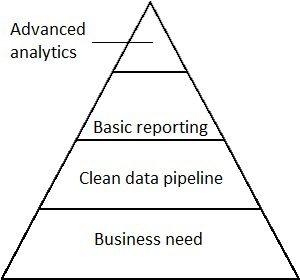In this day and age, you can’t go a day without hearing terms such as “data science,” “big data,” or “analytics.” These terms have been thrown around to apply to so many situations that the original meaning of these words is lost.
So, what does it take for any organization to be successfully data-driven? Although analytics may seem complicated, the solution comes from simplicity.
I believe it comes down to four things, as I’ve illustrated below: business need, clean data pipeline, basic reporting, and advanced analytics.

Business Need
At the end of the day, data science is just like any other aspect of a business: it has to contribute to the bottom line. Fitting that business need is the foundation for analytics.
Collecting data can seem useful, but the process must start with key stakeholders who will be using the data to drive decision making. Who are these stakeholders? How can the data be presented in the most easy to use way?
First, the analytics team must understand how executives, senior management, and others interact with reports, dashboards, and data in general. With this, data can be presented through the most effective channel.
Next, the organization must decide what decisions will be driven with data. Based on that, what metrics must be tracked to enable intelligent decision making? Establishing those core KPIs and statistics is vital.
Clean Data Pipeline
With a business need established, data engineering enters the picture to ensure data gets to the right places. This is the infrastructure of moving information from point A to point B. This process starts with engineering building analytics into every feature, and ends with an analyst building a report or dashboard.
Data engineering is vital since any error through the extract-transfer-load pipeline can lead to incomplete or inaccurate data. Ultimately, an executive has to be able to say “I can trust the numbers I’m seeing.” Any industry expert can tell when the numbers differ from what they should be seeing, and that decreases trust in analytics.
Basic Reporting
Even though we talk about algorithms, one would be surprised how much of analytics is just “how many users joined X” or “what percent of users engaged with Y.” Data science does not require PhD level mathematics to be effective; in fact, it probably should not be.
A product team will combine these straight forward metrics, along with other industry standard KPIs, with their domain knowledge to make decisions.
Advanced Analytics
This is where predictive modeling and other advanced techniques come in. Calculating metrics such as lifetime value (LTV) is vital for any many businesses, and this requires a very strong mathematical foundation.
The key is to remember that LTV cannot happen without the prior foundations: a business that buys in, correct numbers, and basic reporting covered. That’s why this goes on the top of the pyramid.
Remember to focus on the foundation, and build up one step at a time.